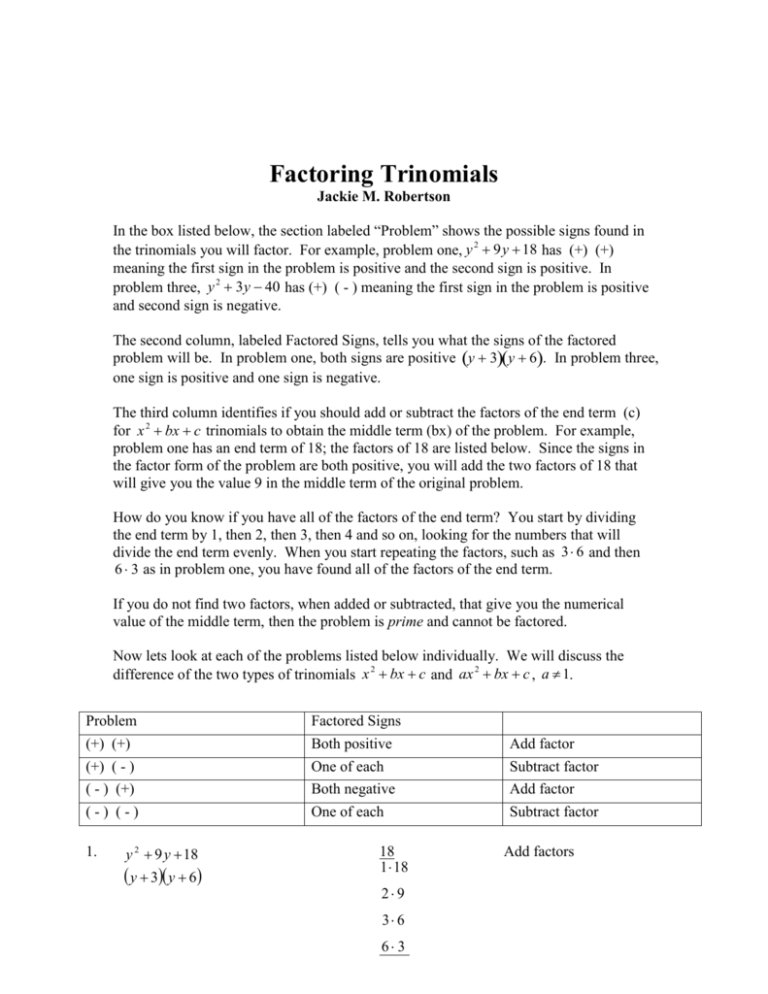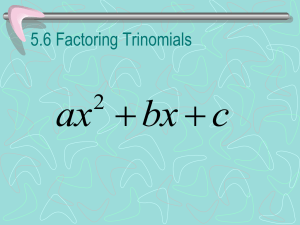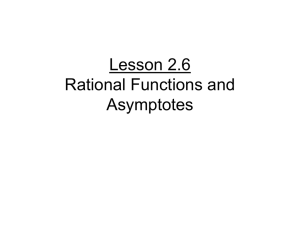Factoring Polynomials
advertisement

Factoring Trinomials Jackie M. Robertson In the box listed below, the section labeled “Problem” shows the possible signs found in the trinomials you will factor. For example, problem one, y 2 9y 18 has (+) (+) meaning the first sign in the problem is positive and the second sign is positive. In problem three, y 2 3y 40 has (+) ( - ) meaning the first sign in the problem is positive and second sign is negative. The second column, labeled Factored Signs, tells you what the signs of the factored will be. In problem one, both signs are positive y 3 y 6 . In problem three, problem one sign is positive and one sign is negative. The third column identifies if you should add or subtract the factors of the end term (c) for x 2 bx c trinomials to obtain the middle term (bx) of the problem. For example, problem one has an end term of 18; the factors of 18 are listed below. Since the signs in the factor form of the problem are both positive, you will add the two factors of 18 that will give you the value 9 in the middle term of the original problem. How do you know if you have all of the factors of the end term? You start by dividing the end term by 1, then 2, then 3, then 4 and so on, looking for the numbers that will divide the end term evenly. When you start repeating the factors, such as 3 6 and then 6 3 as in problem one, you have found all of the factors of the end term. If you do not find two factors, when added or subtracted, that give you the numerical value of the middle term, then the problem is prime and cannot be factored. Now lets look at each of the problems listed below individually. We will discuss the difference of the two types of trinomials x 2 bx c and ax 2 bx c , a 1. Problem (+) (+) Factored Signs Both positive Add factor (+) ( - ) One of each Subtract factor ( - ) (+) (-) (-) Both negative One of each Add factor Subtract factor 1. y 2 9 y 18 y 3 y 6 18 118 29 3 6 6 3 Add factors As mentioned above, in problem one, we look for all of the factors of the end term 18. Since the original problem is (+) (+), the terms of the factored problem will both be positive; therefore, we need to add the two factors of 18 that will give us the numerical value 9 of the middle term. These factors are 3 and 6. 2. a 2 15a 16 a 1a 16 16 116 Subtract Factors 28 44 In problem two we find all of the factors of the end term16. Since the original problem has the signs ( - ) ( - ), the factored form will have a positive sign and a negative sign. You will need to subtract the two factors of 16 that will give you the value 15, in this case the positive and which gets the negative, remember 116 . In deciding which factor gets the largest factor always gets the sign of the middle term in the original problem. In this problem the middle value of 15 is negative, therefore, 16 gets the negative sign and 1 gets the positive sign. 3. y 2 3y 40 y 5y 8 40 1 40 Subtract Factors 2 20 4 10 58 85 In problem three we find all of the factors of the end term 40. Since the original problem has the signs (+) ( - ), the factored form will have a positive sign and a negative sign. You will need to subtract the two factors of 40 that will give you the value 3, in this case 5 8 . In deciding which factor getsthe positive and which gets the negative, remember the largest factor always gets the sign of the middle term in the original problem. In this problem the middle value of 3 is positive, therefore, 8 gets the positive sign and 5 gets the negative sign. 4. a 2 9a 14 a 2a 7 14 114 Add Factors 2 7 72 In problem four we find all of the factors of the end term 14. Since the original problem has the signs ( - ) (+), the factored form will have two negative signs. You will need to add the two factors of 14 that will give you the value 9, in this case 2 7 . Because we added the two factors to get the middle value of 9, both of the signs are the same. In this case they are both negative. 5. 3x 2 13x 4 12 112 3x 13x 12 26 3 3 4 Add Factors 43 3x 1x 4 c , a 1. In this case we multiply the leading Problem five is of the form ax 2 bx coefficient 3 by the end term 4 to get 12. We then find all of the factors of 12, which are listed. The next step is different than most methods of factoring. We put the leading coefficient in both factors, in this case 3. We then find the two factors of 12 that will give us the middle value 13. Since the original problem has (+) (+) we will need to add the two factors. In this case, 1 and 12. Now we will divide by the leading coefficient 3. Three will not divide both terms of the first factor 3x 1, but it will divide both terms of the second factor 3x 12 canceling out the 3 and the 12 to leave x 4 . This gives us the completed factored form 3x 1x 4 . 3 z 2 17 z 20 6. 3z 53z 12 60 1 60 Add Factors 2 30 3 20 3 4 15 3z 5z 4 5 12 6 10 10 6 Problem six is a lot like problem five in that the leading coefficient is 3. We now multiply the leading coefficient 3 by the end term 20 to get 60. We then find all of the factors of 60. Again we put the leading coefficient 3 in both factors. We then find the two factors of 60 that will give us the middle value 17. Since the original problem has ( - ) (+), we will need to add the two factors. In this case, 5 and 12. Now we will divide by the leading coefficient 3. Three will not divide both terms of the first factor 3z 5, but it will divide both terms of the second factor 3z 12 canceling out the 3 and the 12 to leave z 4 . This gives us the completed factored form 3z 5z 4 . 7. 6x 2 63 13x 378 1 378 6x 2 13x 63 0 2 189 6x 146x 27 0 3 127 6 6x 146x 27 0 6 63 2 3 7 54 3x 72x 9 0 9 42 3x 7 0 14 27 7 3 18 21 x Subtract Factors 2118 2x 9 0 9 2 We need to rewrite problem seven in standard form before be can begin factoring. In this problem we are asked to solve for the values of x. First we multiply the leading coefficient 6 by the end term 63 to get 378. This number seems too large at first to find all of the factors easily, but as you can see, it is not difficult at all. Now we put the leading coefficient 6 in both factors. We then find the two factors of 378 that will give us the middle value 13. Since the original problem has (+) ( - ) we will need to subtract the two factors, n this case, 14 and 27. Because we subtracted the two factors to get the middle term, we will have a positive and a negative in the factored form of the problem. Since the middle value 13 is positive, 27 is also positive and 14 is negative. Now we will divide by the leading coefficient 6. Six will not divide both terms of the first factor 6x 14 nor will it will divide both terms of the second factor 6x 27. It is necessary for us to break 6 down to 2 3 . Now 2 will divide the 6 and 14 in the first factor reducing to 3x 7 and 3 will divide 6 and 27 reducing to 2x 9. Because we are solving for x, 7 9 it is necessary to set each factor equal to zero. The resulting values for x are and . 3 2 x 8. 4 x 2 12x 9 4 x 64 x 6 4 4 x 64 x 6 2 2 2x 32x 3 36 1 36 Add Factors 2 18 3 12 49 66 For problem eight we start by multiplying 4 times 9 to get 36 and then we find all of the factors of 36. Put the leading coefficient 4 in both factors and look for the factors of 36 that will give the middle value of 12. The original problem is ( - ) ( - ) so we will need to add the factors These factors are 6 and 6. Now divide by the leading coefficient 4. Four will divide the 4 but not the 6 in both factors. We will need to break down 4 to 2 2 and then divide. The result is 2x 32x 3. This is a special formula that you will learn about in Lesson 28, Perfect-Squares.








